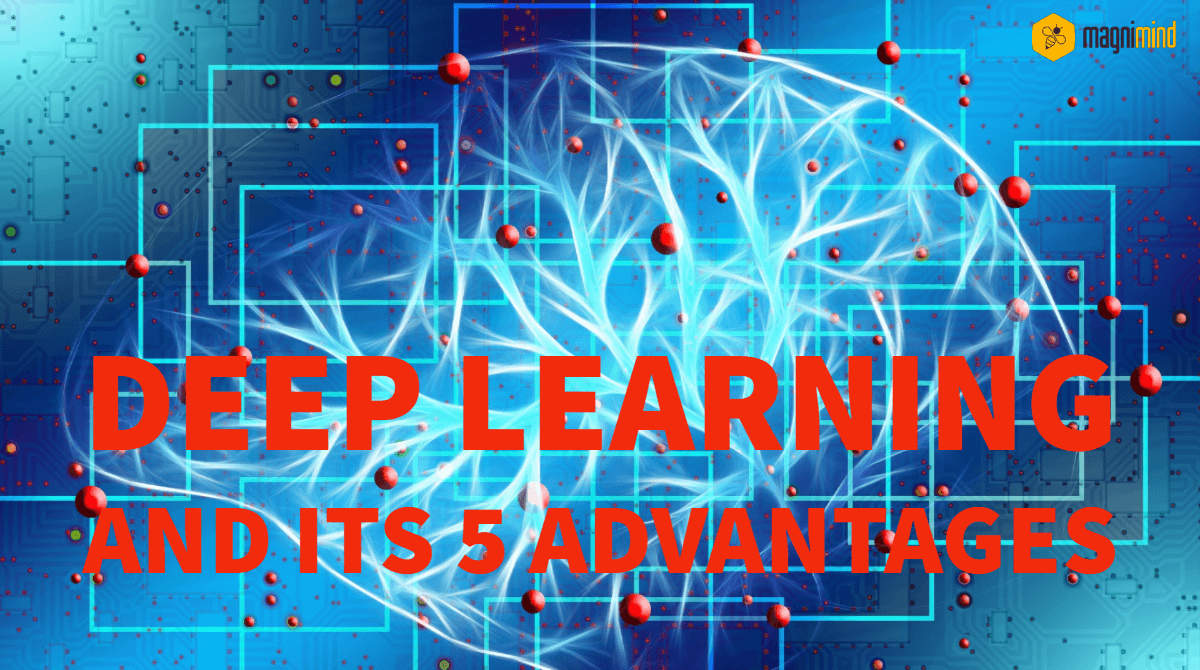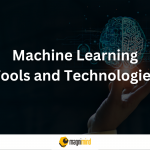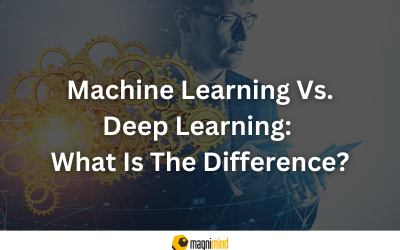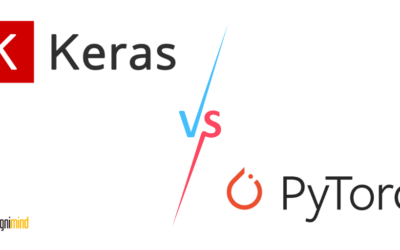Over the past few years, you probably have observed the emergence of high-tech concepts like deep learning, as well as its adoption by some giant organizations. It’s quite natural to wonder why deep learning has become the center of the attention of business owners across the globe. In this post, we’ll take a closer look at deep learning and try to find out the key reasons behind its increasing popularity.
1- What’s deep learning?
Put simply, deep learning is a subset of machine learning which teaches machines to do what humans are naturally born with: learn by example. Though the technology is often considered a set of algorithms which ‘mimics the brain’, a more appropriate description would be a set of algorithms which ‘learns in layers’. It involves learning through layers that enable a computer to develop a hierarchy of complicated concepts from simpler concepts. In deep learning, a model learns to perform tasks directly from text, sound, or images and can achieve incredible accuracy, sometimes more than human-level performance. Deep learning is the central technology behind a lot of high-end innovations like driverless cars, voice control in devices like tablets, smartphones, hands-free speakers etc and many more. It’s offering results which weren’t possible before or even with traditional machine learning techniques.
2- Examples of deep learning in real-world scenarios
A huge number of industries are using deep learning to leverage its benefits. Let’s have a look at a couple of them.
- Electronics: Deep learning is being utilized in automated speech translation. You can think of home assistance devices which respond to your voice and understand your preferences.
- Automated driving: With the help of deep learning, automotive researchers are now able to detect objects like traffic lights, stop signs etc automatically. They’re also using it to detect pedestrians that helps lower accidents.
- Medical research: Deep learning is being used by cancer researchers to detect cancer cells automatically.
3- How deep learning models work?
Majority of the deep learning methods utilize neural network architectures and that’s why deep learning models are widely known as deep neural networks as well. A deep learning process consists of two key phases – training and inferring. The training phase can be considered as a process of labeling huge amounts of data and identifying their matching characteristics. Here, the system compares those characteristics and memorizes them to come up with correct conclusions when it encounters similar data next time. During the inferring phase, the model makes conclusions and labels unexposed data with the help of the knowledge it gained previously.
During the training of deep learning models, professionals use large sets of labeled data together with neural network architectures which learn features from the data directly without the need for feature extraction done manually.
4- How deep learning models are created and trained?
Professionals use deep learning in three most popular ways to perform object classification. Let’s have a look at them.
- Transfer learning: The transfer learning approach is being used by most deep learning It’s a process which involves fine-tuning a pre-trained model. For instance, you begin with an existing network and feed in fresh data that contains previously unknown classes. After doing some modifications to the network, you become able to perform a new task like categorizing only cats or dogs rather than 1000 different objects. This approach also comes with the advantage of requiring much less data, so computation time drops significantly.
- Training from scratch: In order to train a deep learning network from scratch, you’d need to capture a very large labeled dataset apart from designing a network architecture which will learn the features and mimic. This approach is effective for new applications, or for applications which will have a relatively big number of output categories. This is a relatively less popular approach because, with the rate of learning and large volumes of data, the networks typically take significantly more time to train.
- Feature extraction: It’s a more specialized, slightly less common approach to deep learning where the network is used as a feature extractor. Here, all the layers are assigned to learn specific features from images and thus, during the training process, these features can be pulled out of the network at any time. Then these features can be utilized as input to machine learning models.
5- Difference between deep learning and traditional machine learning
Though deep learning was developed as an approach of machine learning, the focus has shifted mainly on deep learning these days and for reasons. Traditional machine learning refers to the process of extraction of knowledge from a large dataset loaded into the machine. Professionals formulate the rules and rectify errors made by the machine. This approach removes the negative overtraining impact which appears frequently in deep learning. In traditional machine learning, a machine is provided with training data and examples to help it make correct decisions. In other words, in a traditional machine learning approach, a machine can solve a significant number of tasks, but it cannot perform them without human control. Let’s have a look at the differences between traditional machine learning and deep learning.
- Deep learning models are capable of creating new features by themselves while in traditional machine learning approach, features need to be identified accurately by users.
- In deep learning, problems are solved on an end-to-end basis while in machine learning, tasks are divided into small pieces and then received results are combined into one conclusion.
It’s implied in the deep learning concept that a machine develops its functionality by itself at the current time as long as it’s possible.
6- 5 Key advantages of using deep learning
You may ask why a significant number of technology giants are steadily adopting deep learning. To understand the reason, we’ve to look at the advantages that can be gained by using a deep learning approach. Here’re five key advantage of using this technology.
6.1- Maximum utilization of unstructured data
Research from Gartner revealed that a huge percentage of an organization’s data is unstructured because the majority of it exists in different types of formats like pictures, texts etc. For the majority of machine learning algorithms, it’s difficult to analyze unstructured data, which means it’s remaining unutilized and this is exactly where deep learning becomes useful. You can use different data formats to train deep learning algorithms and still obtain insights which are relevant to the purpose of the training. For instance, you can use deep learning algorithms to uncover any existing relations between industry analysis, social media chatter, and more to predict upcoming stock prices of a given organization.
6.2- Elimination of the need for feature engineering
In machine learning, feature engineering is a fundamental job as it improves accuracy and sometimes the process can require domain knowledge about a certain problem. One of the biggest advantages of using deep learning approach is its ability to execute feature engineering by itself. In this approach, an algorithm scans the data to identify features which correlate and then combine them to promote faster learning without being told to do so explicitly. This ability helps data scientists to save a significant amount of work.
6.3- Ability to deliver high-quality results
Humans get hungry or tired and sometimes make careless mistakes. When it comes to neural networks, this isn’t the case. Once trained properly, a deep learning model becomes able to perform thousands of routine, repetitive tasks within a relatively shorter period of time compared to what it would take for a human being. In addition, the quality of the work never degrades, unless the training data contains raw data which doesn’t represent the problem you’re trying to solve.
6.4- Elimination of unnecessary costs
Recalls are highly expensive and for some industries, a recall can cost an organization millions of dollars in direct costs. With the help of deep learning, subjective defects which are hard to train like minor product labeling errors etc can be detected. Deep learning models can also identify defects which would be difficult to detect otherwise. When consistent images become challenging because of different reasons, deep learning can account for those variations and learn valuable features to make the inspections robust.
6.5- Elimination of the need for data labeling
Data labeling can be an expensive and time-consuming job. With a deep learning approach, the need for well-labeled data becomes obsolete as the algorithms excel at learning without any guideline. Other types of machine learning approaches aren’t nearly as successful as this type of learning.
Final Thoughts
Keeping in mind the above and more advantages of using deep learning approach, it can be said that it’s obvious to experience the impact of deep learning in different high-end technologies like Advanced System Architecture or Internet of Things in the future. We can expect to see more valuable contributions to the larger business realm of connected and smart products and services. These days, deep learning has come a long way from being just a trend and it’s quickly becoming a critical technology being adopted steadily by an array of businesses, across multiple industries.
. . .
To learn more about python, click here and read our another article.










